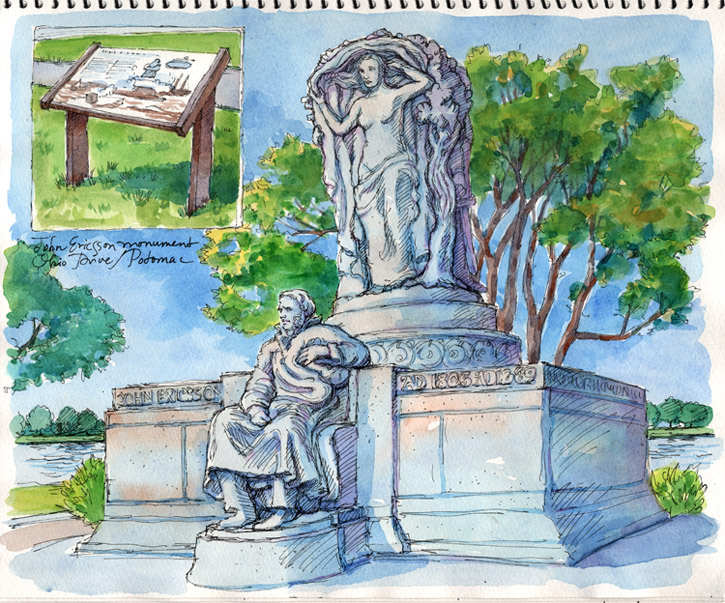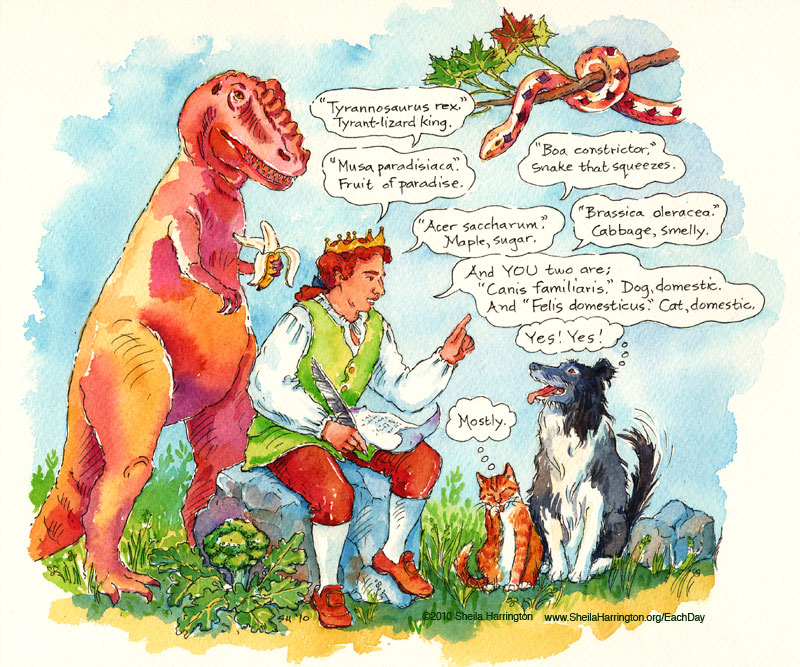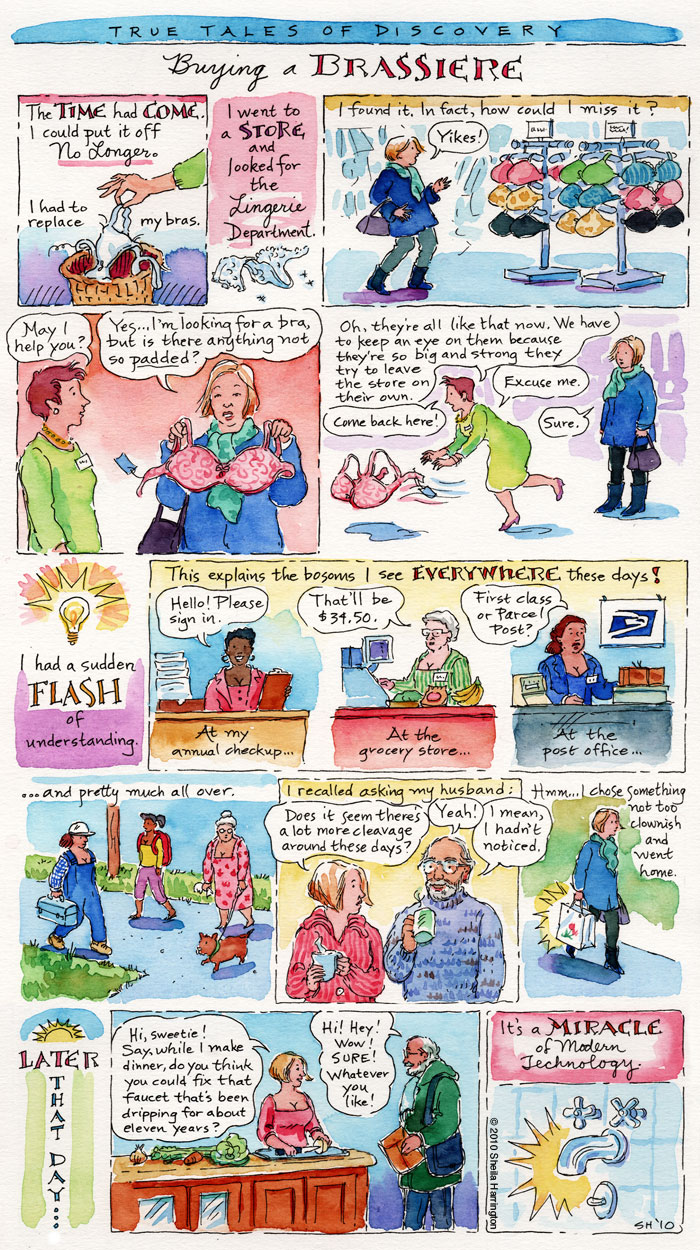It is not an actual egg we seek, but the electric car built by Paul Arzens during WWII that he showed us when we were living in Paris in the late 70s.
Tag: Invention
How Did We Ever Manage Without You?
Father of the Monitor
Where in Washington, DC—a city not known for its ancient fanciful mythology, except of the political kind—can you find an outdoor sculpture of Yggdrasil, the World Tree of Norse legend?
If you are zipping along in a car, you’ll miss it. But if you are traveling by foot or bicycle, you can take a break on a small green island (which I discovered by accident on a family bike ride, and returned to sketch) at the intersection of Ohio Drive and Independence Avenue, along the Potomac River. There at the foot of Yggdrasil sits John Ericsson (1803-1889), whose birthday it is today.
Ericsson, born in a Swedish village and son of a mining engineer, was a precocious child who demonstrated early an aptitude for all things mechanical. At five he created a working windmill from clock parts and household utensils. There is no historical record of his mother’s reaction to the missing tableware. At eight his education included informal instruction from his father’s engineering colleagues, and eventually he joined the team (although still too small to reach all the equipment), drawing up plans and supervising crews. During a period in the army he worked on designs for steam and fume-propelled engines, but finding no funding he took himself to England (leaving behind an out-of-wedlock son to be raised by his mother), which was then the hub of the Industrial Revolution and a showcase for new canals, railways, factories, and every sort of engine and mechanical device.
But despite his innovations in locomotive and marine engine designs, and his best-known creation, the screw propellor—which rendered vessels far more efficient and whose descendants are still in use worldwide—the English were unresponsive, perhaps because of Ericsson’s reputedly uncompromising nature, or perhaps because of his foreign origins. So Ericsson (leaving behind an English wife) betook himself to the young United States, with its energetic, ambitious entrepreneurs, and settled in New York, where pretty much everyone had (as today) foreign origins.
Here Ericsson sought supporters within the Navy and private industry for his screw-propellor vessel designs. He also tried, unsuccessfully, to interest the French Emperor, then engaged in the Crimean War, in a new rather peculiar-looking design for an iron-clad vessel (iron-clad ships having shown their effectiveness against the traditional wooden model).
But it was the American Civil War that delivered his opportunity. When the Southern states seceded from the Union in 1861, taking with them the Navy Yard at Norfolk and the USS Merrimac, which the Confederacy began to sheath with iron, it became obvious that the U.S. needed its own ironclad ship to protect the Northern coastal blockade. Ericsson’s industrial business contacts, who saw war as a terrific opportunity to increase their fortunes patriotically, used their influence within Congress and the U.S. Navy to advocate the implementation of Ericsson’s ingenious design, negotiate a contract, and launch construction of a vessel, in an unbelievably short period.
Ericsson’s ironclad ship (named the Monitor by Ericsson, as it was intended to monitor the coastline), with its iron sheath extending below the water line, its revolving turret that permitted it to fire in all directions, and its screw propellor, kept iron works, foundries, rolling mills, and manufacturers busily employed for months. For the sake of speed, some of its innovations (such as the underwater torpedo) were set aside, to be adopted later. Some were ignored, to the ship’s peril, as we will see.
Because the strange new vessel was untested, its crew was composed primarily of volunteers. Some observers (untutored in the laws of physics) predicted she would sink instantly when launched on March 6, 1862, headed for Norfolk. However, although the Monitor endured rough weather (and leaks, due to the Navy’s having ignored Ericsson’s instructions for the turret’s sealing), she arrived safely in Hampton Roads on March 8th, to find disaster: two ships already destroyed by the Confederacy’s Merrimac, and two others run aground awaiting their own coups de grâce.
For, during the past few months, the Confederacy had been hurriedly adapting the Merrimac (which they renamed the Virginia), preparing it to ram and sink the Yankee ships at Hampton Roads, to break the blockade and enable the resumption of Southern trade. Because the Union and the Confederacy were both riddled with spies, each knew something of the other’s ship-building progress, so perhaps it is not simply an amazing coincidence that the two vessels were completed and launched only a couple of days apart. In any case, news of the Merrimac’s success ran through the telegraph lines, thrilling the South and alarming the North, who feared that the Merrimac would next turn northward to destroy its coastal cities. This was impossible; the Merrimac was clumsy, leaky, and barely seaworthy enough to have made it across Hampton Roads. But the North didn’t know that.
When the Merrimac returned to finish off the last two vessels, it found a small, oddly shaped object—the Monitor—pluckily barring its way. At first the Merrimac’s crew believed the Monitor to be a supply barge, until it fired upon them. Battle between the two ironclads continued for several hours, with each trying to inflict damage upon the other, the Merrimac attempting simultaneously yet unsuccessfully to attack the nearby remaining Northern ships. The Monitor, small, nimble, and quick, protected the ships from further damage, and eventually the Merrimac retired leaking to its port.
Both sides (naturally) declared victory in the battle, but the ultimate outcome was a contract between John Ericsson and the U.S. Navy for a fleet of ironclads, and the successful blockade of the South. The poor Monitor, however, caught in a storm at sea later that year (the Navy still ignoring Ericsson’s instructions on the proper sealing of its turret), went down with sixteen hands off the coast of Cape Hatteras. (Some of her artifacts have since been recovered and conserved.)
Ericsson, who had had a number of professional disappointments, was now vindicated and rewarded, and went on to work in maritime and naval technology and experiment with various sources of power—steam, electric, solar. Three Navy ships have been named after him, and in 1926 the monument pictured above, created by sculptor James Earle Fraser, was dedicated to him. There sits Ericsson (curiously, looking inland rather than out over the Potomac) beneath the Norse World Tree, with Vision standing behind him, flanked by Labor and a Viking warrior. It’s one of your more surprising Washington, DC sculptures. Go have a look.
Although Ericsson regularly sent funds for the support of that son and wife back in Sweden and England, his true passion was engineering, and neither ever joined him in the New World. Thus his days and nights were uninterrupted by the distracting joys and troubles of family life. Ericsson had a reputation for being stubborn, imperious, and single-minded, and perhaps these qualities do not a family man make… but they might enable one to overcome opposition and discouragement and press forward undespairing. Happy Birthday, husband and father of the Monitor.
Prince of Binomial Nomenclature: Part 2
Continued from Prince of Binomial Nomenclature: Part 1, May 23rd
Longing to expand his perspective, Linnaeus applied for and received a grant for a field expedition to Lapland, a rugged region above the Arctic Circle, where he expected to find many unrecorded species. Linnaeus spent five months exploring and studying rocks, plants, insects, animals, and people, and returned with thousands of specimens (no people though), filled with excitement. He returned to lecturing, and planned a series of books cataloguing species according to his new system.
Linnaeus DID actually long for a reproductive life of his own. He paid court to a young lady whose father, not taking a wandering botanist very seriously, insisted that Linnaeus wait three years and meanwhile establish some means of supporting a family. So Linnaeus went off to Holland, whose universities were better equipped than those of Sweden, to complete his medical degree. He also found work there managing and classifying the contents of Dutch zoological and botanical gardens.
THEN, in 1735, while still in Holland, he published his book Systema Naturae, which explained his concept of classification. Linnaeus grouped plants and animals into genera—groups whose members have something in common, usually structural or related to reproduction. (Linnaeus was the first to classify whales as mammals.) Then he subdivided each group into species. (His complete heirarchy, as you may recall from high school, is Kingdom, Class, Order, Genus, and Species.) And then he gave each member a two-part name based on these divisions, replacing all previously-used cumbersome lengthy descriptions. These two-part names were in Latin, which was, and still is, the universal language of science. I told you those Latin classes would come in handy.
Systema Naturae hit the botanical world like a bolt of lightning. The notion that PLANTS (seemingly so innocent!) had a Sexual Life, by which Linnaeus partly categorized them, was outrageous and horrifying to some naturalists, and Linnaeus was criticized for “nomenclatural wantonness.” But, despite objections on both theological and moral grounds, Linnaeus’ achievement launched him from obscurity to fame. A binomial concept had been proposed by Swiss botanist Gaspard Bauhin in 1623 but was never widely used. When Linnaeus combined it with his new categorization methods, the idea spread rapidly. Here was a practical tool: reasonable, memorable, universally applicable. Not only could scientists from different countries know they were communicating about the same species; it was even easy for amateurs to use, and it sparked a more widespread interest in natural history. Such is the effect of nomenclatural wantonness.
Now back in Sweden as an established botany professor, Linnaeus was able to marry his fiancée, although he spent so much time away on expeditions that she might have been happier with one of her other suitors. He lectured, wrote many works on botany, corresponded with other naturalists, revised and expanded Systema Naturae many times throughout his life (it eventually reached 2,300 pages), led collecting expeditions, and inspired his students to travel throughout the world as botanical and zoological explorers. One circumnavigated the world with Captain Cook. Others went to North America, Japan, China, and Southeast Asia, returning with specimens (or occasionally dying in a distant land; collecting could be dangerous work). Eventually he was knighted for his contributions to science and became Carl von Linné. So there, Mom and Dad.
Linnaeus himself gave scientific names to 4,200 animals and 7,700 plants, generally choosing names to reflect physical qualities, but occasionally to honor a friend or colleague, or, with a particularly ugly or toxic specimen, to insult someone who had annoyed him. Be wary of affronting a botanist. They are still lurking out there today…naming species.
With some modifications due to our modern understanding of evolution, Linnaeus’ system is still in use today, and pretty much taken for granted. But whenever you say Homo sapiens, or Boa constrictor, perhaps now you will think of Carolus Linnaeus, who made it possible, and you will celebrate his birthday every May 23rd. If you weren’t doing so already.
Throughout his life Linnaeus was a deeply religious fellow. He saw his work as clarifying for the world the underlying connections among living things and confirming the intelligence of a great Creator. Ironically, however, because his work made possible far greater understanding and communication among naturalists everywhere, it led to observations of surprising patterns and eventually to the shocking speculation by Charles Darwin and Alfred Russell Wallace that species, instead of having been from their Day of Creation exactly as we know them now, had perhaps changed over time. Over a long, long time. We do not know the ultimate consequences of our life’s work.
Energy-Efficient Vehicle #4
Energy-Efficient Vehicle #3
Energy-Efficient Vehicle #2
Energy-Efficient Vehicle #1
Mother of Level Measurements
If you were an American housewife setting out to bake a cake or a loaf of bread in the 19th century—or the 18th—or the 17th—you generally relied upon what you had learned at your mother’s side. You assembled flour and milk and sugar and milk and shortening and eggs, estimating amounts as best you could and combining them from memory in the proper order. In 1303 Edward I of England had standardized the pound, and the American colonists brought with them, and still use today, the old English standards of measurement (the British have revised their system several times since then, so we no longer match), and most farm wives could measure in pounds, pecks, and bushels. But as for smaller units you were on your own with vague descriptions (“a dab of cream” “a piece of butter as large as an egg”) or whatever teacups you were fortunate enough to possess.
That is, until Fannie Farmer (1857-1915), who was born on this day in Medford, Massachusetts. Her father was an editor and printer, and her parents believed in higher education for girls, but Fannie suffered a stroke at age 16 (!), which prevented her attending college. What she could do, however, was take up responsibility for the household’s cooking. Evidently she had a natural talent. When the family home became a boarding house, it gained a reputation for its fine meals.
So Farmer was encouraged by a friend to obtain teacher training at the Boston Cooking School, which took a scientific approach to food preparation, and she did so well that she stayed on to become Assistant Principal and then Principal in 1891. And in 1896, Farmer published The Boston Cooking-School Cookbook.
Now, cookbooks were not unknown to American housewives. Amelia Simmons’ American Cookery had been self-published in 1796, with colonial favorites like pumpkin pudding, watermelon pickles, and spruce beer (Mmmm!), and by the late 19th century there was an explosion of cookbooks by women, offering medical mixtures (“A wash to prevent the hair from falling off”) and household advice (“Words of Comfort for a Discouraged Housekeeper”—now there’s one we could use) as well as recipes.
Farmer’s cookbook was even more comprehensive, including sections on the chemistry of cooking and cooking techniques, the specific components of food and why each was necessary for health, how a stove works, how flour is milled, what happens during fermentation, and extensive detailed advice on caring for the sick. In addition to these she offered recipes with straightforward, precise directions and—Ta-Daaa!—Actual Measurements, the tools for which (the standard measuring cup, divided into ounces, and graduated measuring spoons) she had created earlier. The publisher, Little, Brown, had “little” faith in the book’s success, and insisted Farmer foot the printing bill herself. When the book became hugely popular (it has sold millions of copies and has never been out of print), this turned out very well for her because she had retained copyright. Ha! Unlike poor Irma Rombauer who unfortunately sold her rights for $3,000 to Joy of Cooking’s publisher.
Farmer’s success enabled her to open her own cooking school. She wrote other books, one of them focusing on cooking for the invalid; was invited to lecture at Harvard Medical School (which lectures were widely printed and read); wrote a regular cooking column in the Woman’s Home Companion; and continued to test and invent recipes and to lecture until the last few days of her life.
You can find Fannie Farmer’s cookbook today—in its 13th edition—at your local library and bookstore. And to celebrate the birthday of the “Mother of Level Measurements,” as she was called, you can make Fannie Farmer’s “Birthday Cake.” If you own a measuring cup and spoons, that is. I have the recipe right here, and if you email me, I will send it to you. (It may be straightforward by 19th century standards but it’s waaay too long to include here.)


















